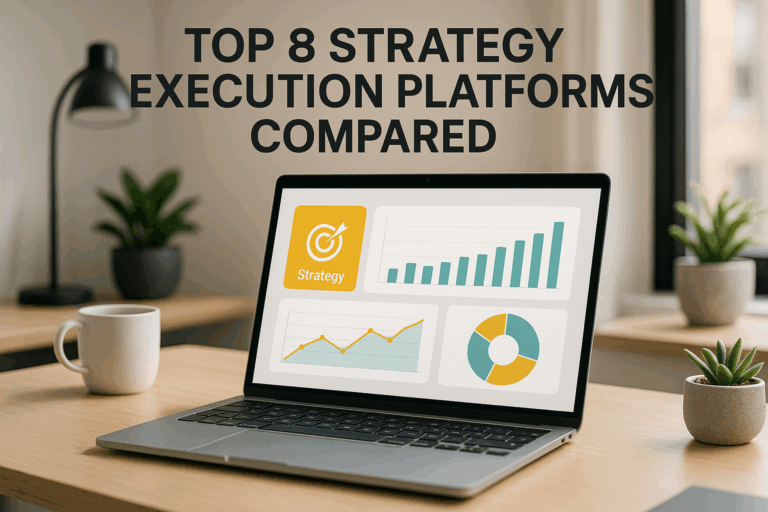Looking for the best tools to turn plans into results? This article compares eight platforms designed to help businesses execute their strategies effectively. For German companies, compliance with strict regulations like GDPR, GoBD, and the IT Security Act 2.0 is critical. These platforms offer features like AI-driven insights, real-time tracking, and audit-ready documentation to meet these demands.
Here’s what you’ll learn:
- GrowthSquare: AI-powered insights with a focus on team alignment.
- StratRocket: Simplifies planning with visual strategy mapping.
- i-nexus: Strong governance tools for large enterprises.
- Quantive: OKR-focused with predictive analytics.
- Perdoo: Goal-setting and team alignment made simple.
- WorkBoard: Links tasks to outcomes with real-time updates.
- AchieveIt: Connects strategic goals to operational tasks.
- Cascade: Visual dashboards and seamless integration options.
Quick Comparison:
| Platform | Strengths | Weaknesses |
|---|---|---|
| GrowthSquare | Focused on Team alignment with AI based prediction of achievements, compliance focus | Requires organization working with the Art of Acceleration methodology |
| StratRocket | Visual strategy mapping | Limited AI insights |
| i-nexus | Governance, audit trails | Overwhelming for small teams |
| Quantive | OKR integration, user-friendly | Lacks depth for complex plans |
| Perdoo | Team alignment, goal setting | Basic reporting |
| WorkBoard | Real-time updates, mobile-friendly | Limited customization |
| AchieveIt | Task integration, tracking | Cluttered interface |
| Cascade | Visual dashboards, integrations | No advanced AI features |
Each platform has strengths and trade-offs. The right choice depends on your business size, goals, and compliance needs.
1. GrowthSquare
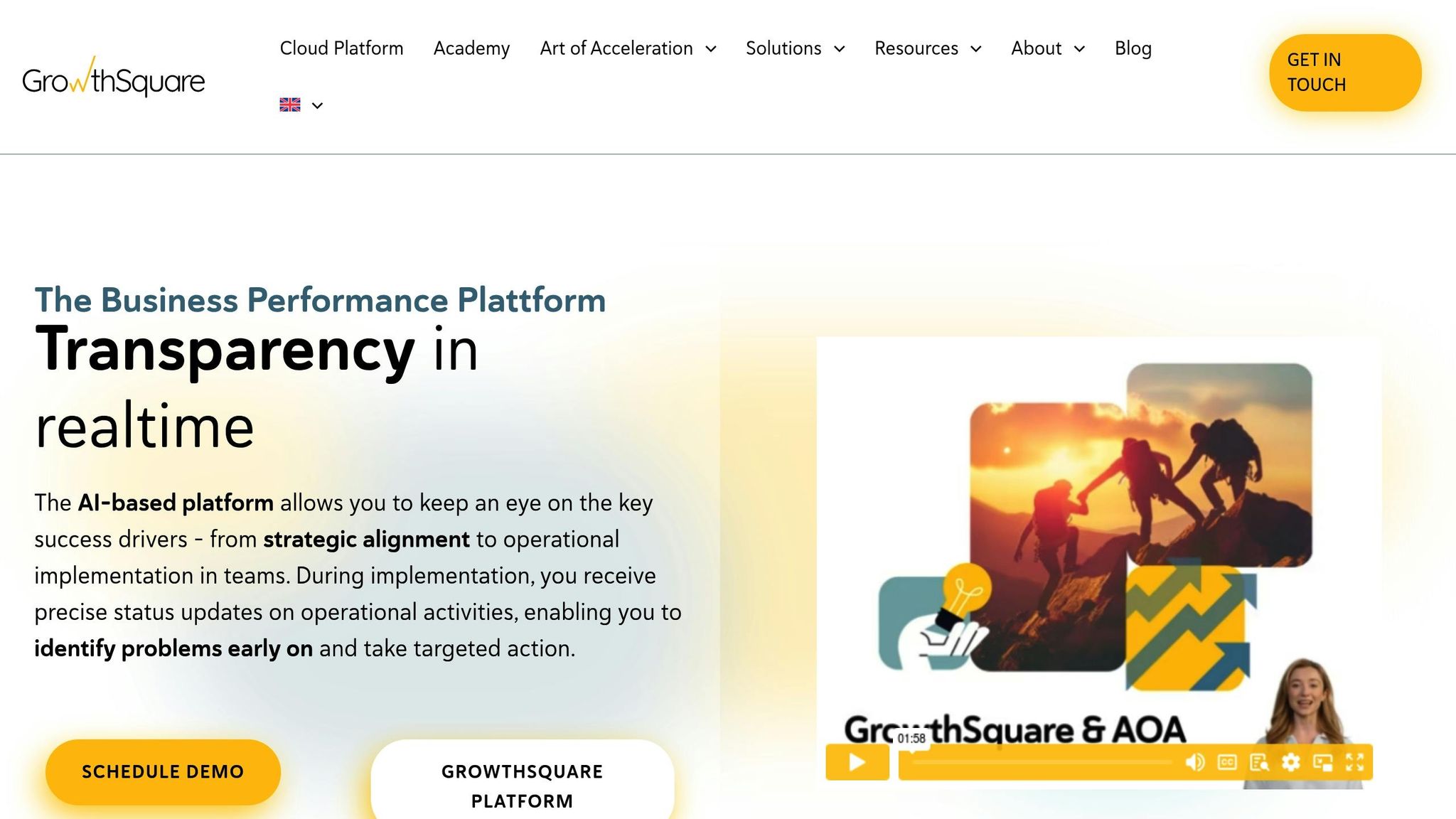
GrowthSquare has emerged as Austria’s answer to tackling the challenges of strategy execution. It offers a platform that blends AI-powered insights with the Art of Acceleration (AOA) framework. Unlike traditional OKR methods, GrowthSquare focuses on the human side of strategy and ensures organizational alignment. Its hallmark is fostering a "shared reality" across teams, meaning everyone works from the same reliable data, reducing the risk of conflicting priorities.
AI Capabilities
At the heart of GrowthSquare is an AI engine designed to predict outcomes and refine strategies before they’re fully implemented. By analyzing historical data, market trends, and internal resources, the platform provides actionable insights and flags when strategic assumptions may need a second look.
The AI also keeps a constant eye on market data, tracking relevant indicators and trends. When shifts occur, it alerts teams to revisit their strategies. These insights feed directly into real-time performance monitoring, ensuring decisions are always based on the most up-to-date information.
Real-Time Monitoring
The Business Performance Cockpit offers real-time tracking of performance across departments. Unlike traditional reporting tools that rely on periodic updates, GrowthSquare provides live updates, allowing managers to address issues as they arise. This proactive approach ensures financial metrics, operational KPIs, and strategic milestones are consistently measured across all departments.
For German companies, especially those operating in diverse regions or business units, this consistency is invaluable. The platform also identifies misalignments early, helping organizations stay on track while meeting strict compliance standards.
Compliance Features
Compliance is a key concern for businesses in Germany, and GrowthSquare addresses this with robust features tailored to regulatory requirements. It processes personal data in full compliance with the European General Data Protection Regulation (GDPR). A Data Processing Agreement (DPA) is automatically included as part of the platform’s General Terms and Conditions, eliminating the need for additional paperwork.
Audit-proof archiving ensures that all decisions, performance data, and compliance records are tamper-proof and readily available for regulatory inspections. The platform also tracks every major strategic update with timestamps and user details, creating a transparent record of accountability.
Integration Options
GrowthSquare integrates seamlessly with ERP, CRM, and financial systems to create a unified strategic dashboard. For enterprise clients, custom integrations allow the connection of proprietary or industry-specific tools. Its API architecture supports both real-time data synchronization and batch processing, catering to varied data management needs and performance expectations.
2. StratRocket
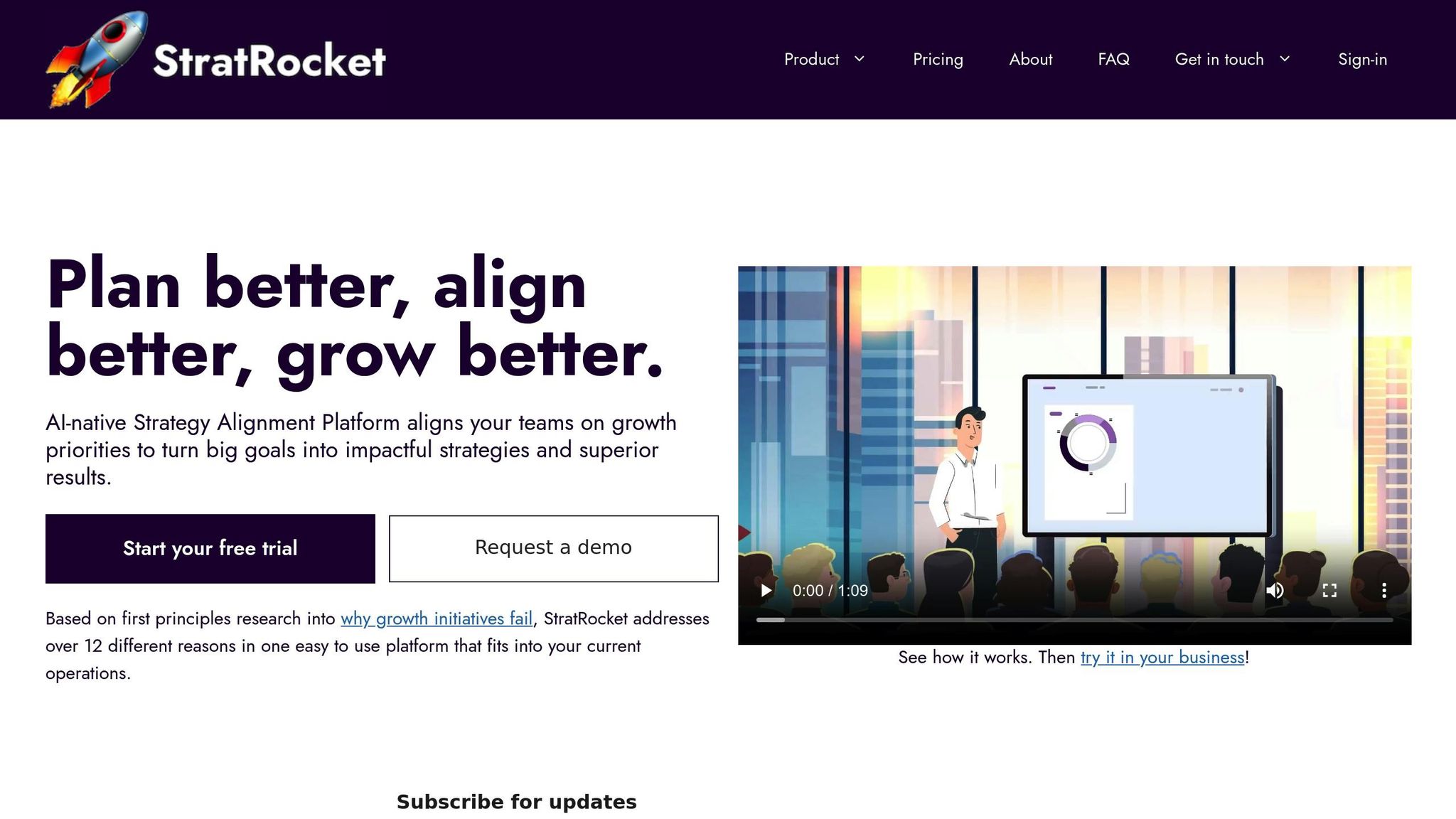
StratRocket is an AI-powered Strategy Alignment Platform designed to bridge the gap between strategic planning and execution.
AI Capabilities
This platform uses advanced AI tools, such as Adaptive Planning, to deliver real-time insights. These insights enable organisations to adapt their strategies as market dynamics shift, ensuring they remain responsive and relevant.
Real-Time Monitoring
StratRocket provides progress dashboards and integrated tracking features that give users instant visibility into their strategic plans and goal structures. With tools to define, monitor, and adjust strategies, it supports agile decision-making in response to evolving conditions. Additionally, its reporting tools promote transparency and accountability across teams and departments, ensuring alignment at every level. These features establish a solid foundation for comparing StratRocket with other platforms in the market.
3. i-nexus
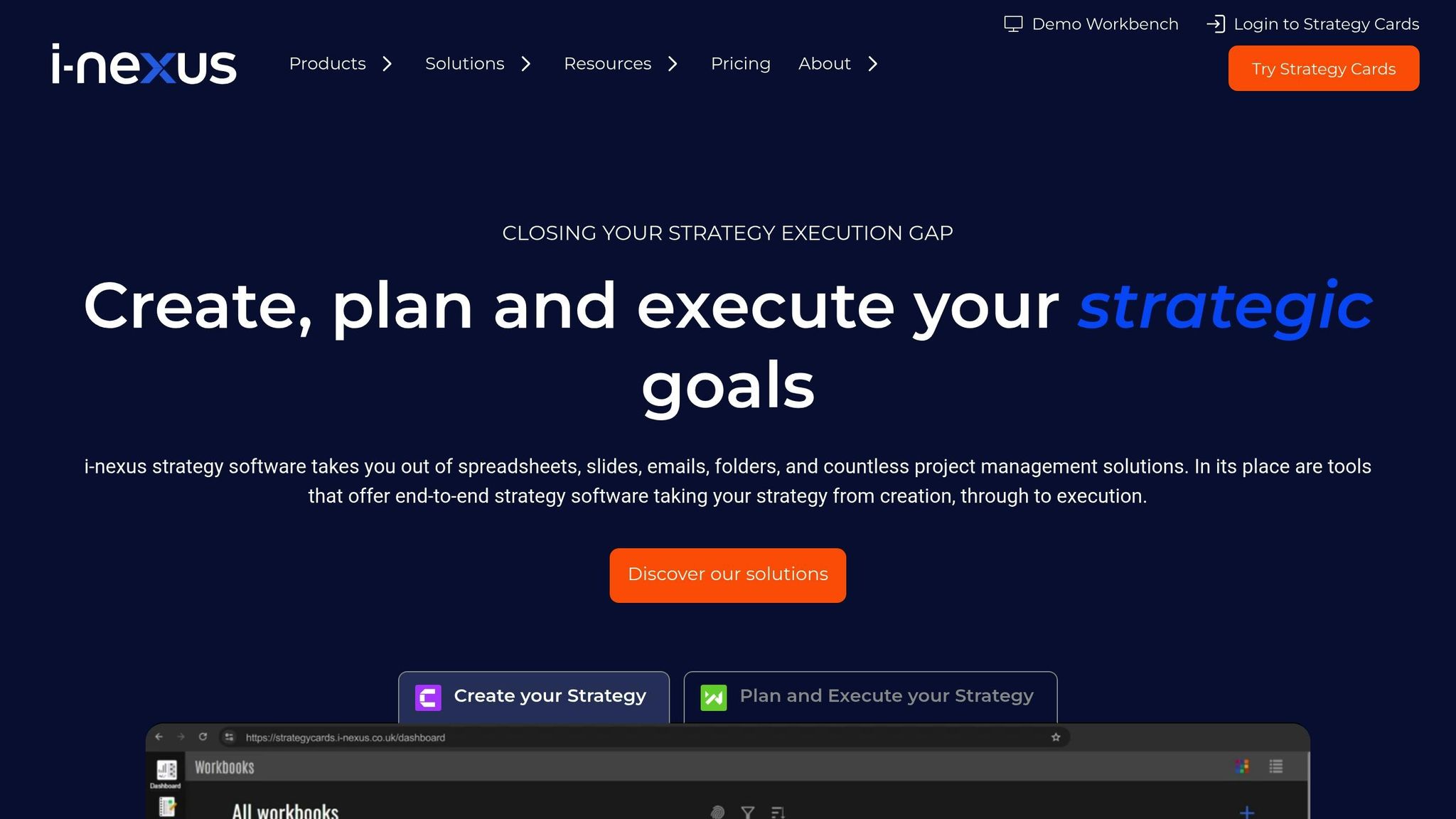
i-nexus brings business systems together with its Strategy Cards feature, offering a streamlined approach to strategy execution. This blend of AI capabilities and unified analytics is especially relevant for German companies navigating regulatory demands and the need for strategic flexibility. By focusing on integration, i-nexus sets the foundation for its AI-driven strategy tools.
AI Capabilities
At the heart of i-nexus is its Strategy Cards, which leverage AI to provide actionable insights and guide strategic planning. This aligns with a broader industry trend: 66% of organisations are either already using or planning to adopt AI for strategy execution. The growing reliance on AI highlights its role in improving decision-making processes.
The Strategy Execution Forum 2025 has also identified "AI & Digital Strategy Platforms" as a key driver for future execution, predicting a shift from static tracking methods to AI-powered insights and automation. i-nexus taps into this transformation with its AI-enhanced tools, which work seamlessly alongside its integrations with essential business software.
Integration Options
i-nexus functions as a central hub, connecting critical business systems and removing the need for fragmented tools. This approach simplifies workflows and enhances collaboration by integrating with a wide range of platforms.
- Microsoft ecosystem: i-nexus integrates with Office 365, Dynamics 365, Outlook, Teams, and Azure, ensuring compatibility with widely used business tools.
- Google Workspace: For organisations using GSuite, i-nexus offers seamless integration, catering to diverse productivity needs.
- Project management tools: The platform connects with Trello and Jira, while also supporting Clarizen and Mevisio for more specific project requirements.
- CRM and cloud infrastructure: Salesforce integration covers customer relationship management, and AWS connectivity addresses cloud-based needs.
- Data visualisation: Power BI integration allows businesses to create detailed dashboards and reports, supporting data-driven decisions.
4. Quantive
Quantive is a platform designed to help German enterprises achieve their goals through a mix of OKRs (Objectives and Key Results) and advanced analytics. By blending traditional goal-setting methods with cutting-edge tools, it offers a structured way to handle strategic planning. Let’s break down how its AI features, real-time monitoring, and compliance tools contribute to better performance.
AI Capabilities
Quantive’s AI tools are built to align with the data-driven demands of today’s business world. They analyze past performance, suggest realistic targets, and offer predictive insights to help avoid setting goals that are either too ambitious or too conservative.
The platform’s machine learning algorithms adapt over time, improving their recommendations based on user behavior and performance trends. For German companies operating in sectors with strict regulations, these AI-driven insights provide the level of precision needed to back up decisions with solid data, keeping both stakeholders and regulators satisfied.
Real-Time Monitoring
Quantive’s real-time dashboard is a game-changer for tracking strategic initiatives. It updates key metrics automatically as new data comes in from connected systems, doing away with the delays caused by manual reporting.
For German manufacturers, this instant access to data is especially useful. It allows them to spot bottlenecks in their processes quickly and reallocate resources to keep things on track. Automated alerts flag any deviations from expected performance, helping teams address potential problems before they grow into bigger issues.
Compliance Features
When it comes to compliance, Quantive has it covered. The platform includes a detailed audit trail that logs every change made to objectives, results, and performance data. This ensures that all actions are documented for internal audits and regulatory reviews.
Quantive keeps track of user actions, data updates, and system integrations, creating a clear record of how strategies are executed. This meticulous documentation aligns with Germany’s Ordnungsmäßigkeit principles, providing transparency and traceability for all strategic decisions.
Integration Options
Quantive’s ability to integrate with other systems is another strength. It works seamlessly with SAP, which is widely used by German businesses, ensuring that operational data flows smoothly into the platform for strategic planning.
Beyond SAP, Quantive connects with Microsoft 365, Google Workspace, and popular project management tools like Asana and Monday.com. For businesses relying on specialized software, the platform’s API capabilities allow for custom integrations, making sure no important data source is left out of the equation.
5. Perdoo
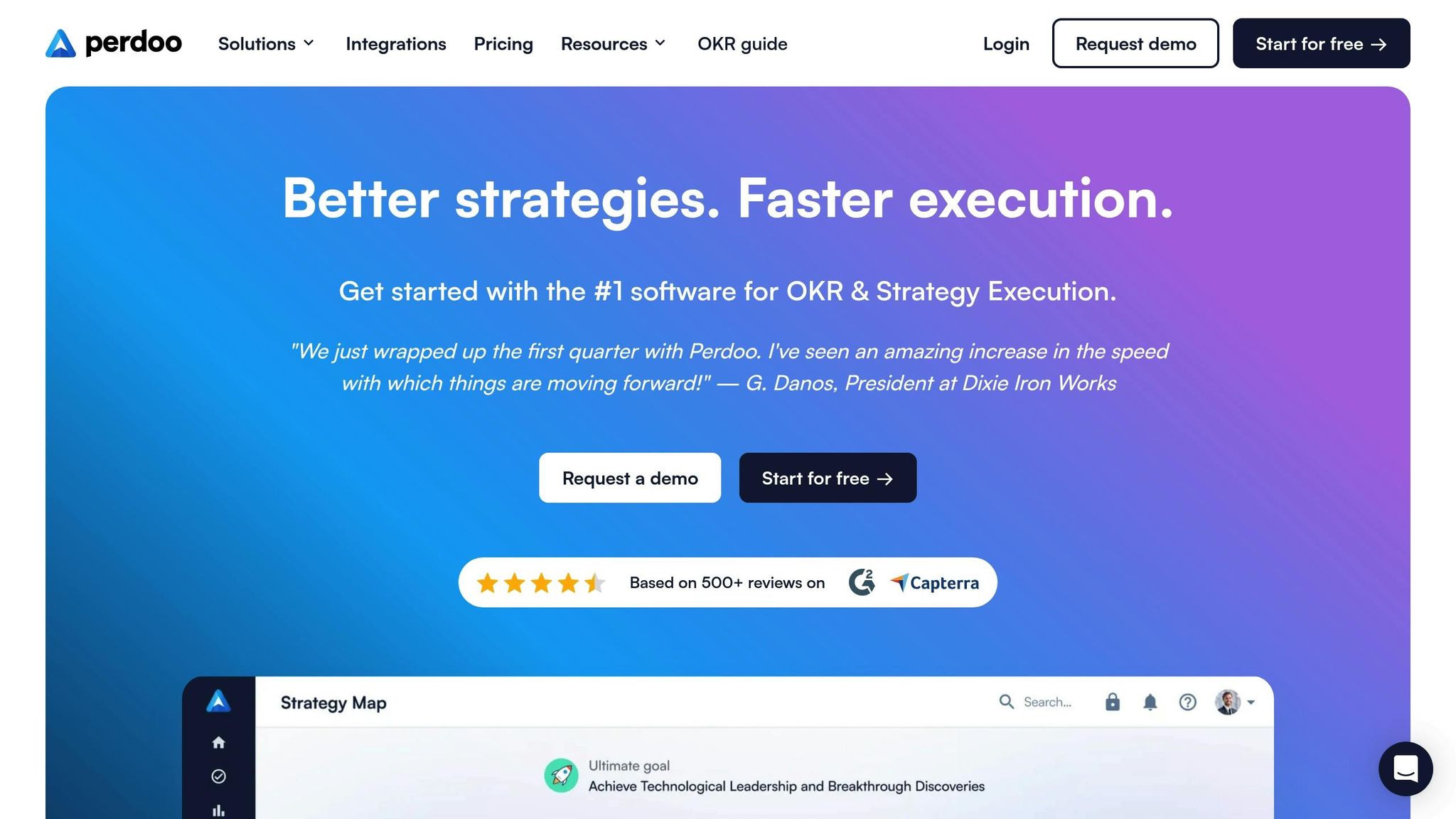
Perdoo is a strategy execution platform built around the OKR (Objectives and Key Results) framework, combined with detailed performance tracking. Tailored primarily for European businesses, it helps organizations turn their strategic goals into measurable outcomes while maintaining alignment across teams and departments. What sets Perdoo apart is its ability to merge performance tracking with real-time data insights, allowing businesses to adapt their strategies swiftly – all while adhering to strict European regulatory requirements. This focused approach makes Perdoo a noteworthy choice among strategy execution platforms.
sbb-itb-4b82ce2
6. WorkBoard
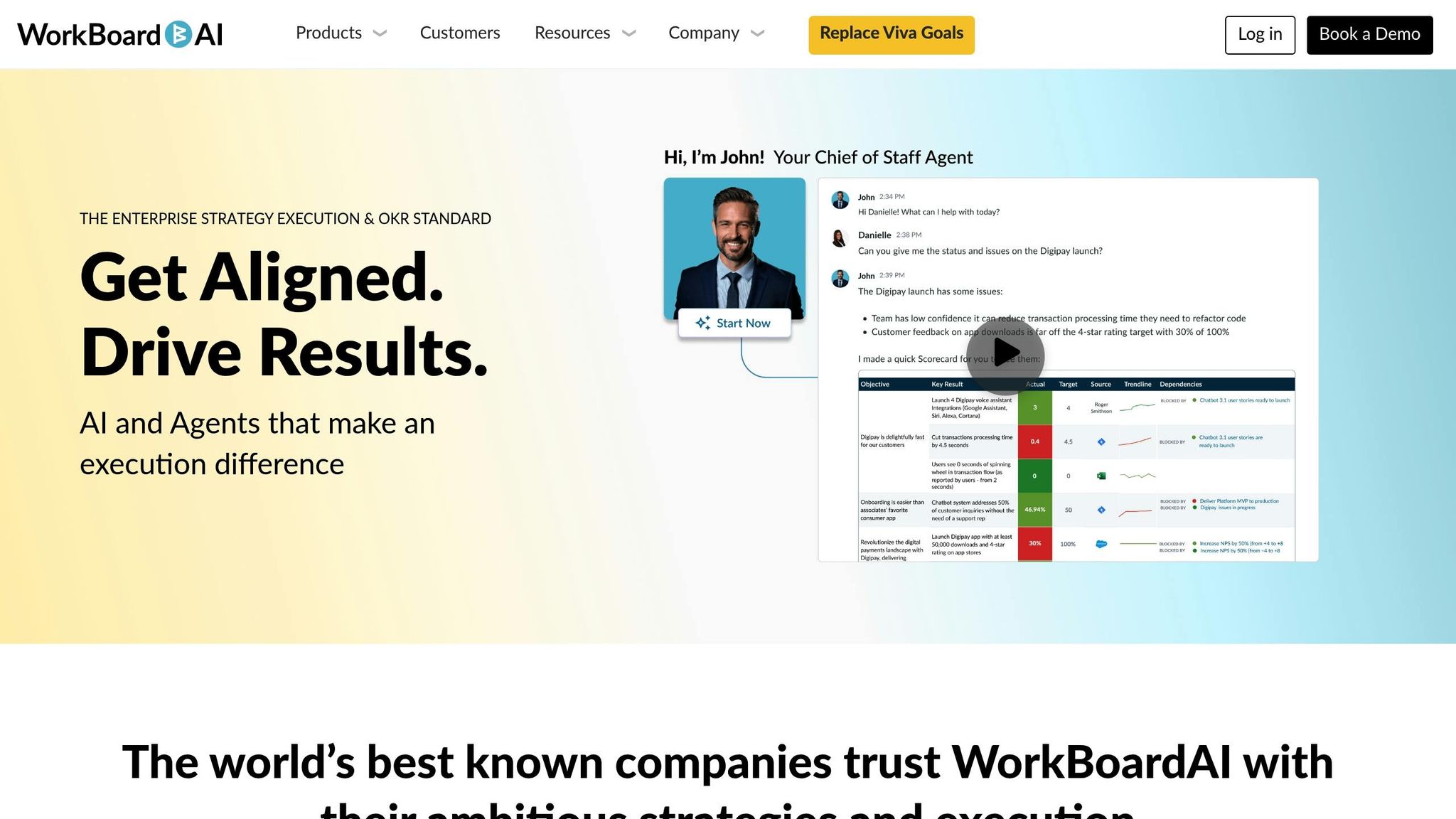
WorkBoard is a strategy execution platform designed to align high-level objectives with everyday tasks. By combining strategic planning with operational execution, it helps organizations ensure their goals are not just lofty ideas but actionable outcomes. The platform emphasizes accountability and provides real-time tools to track progress effectively.
What sets WorkBoard apart is its ability to connect individual actions directly to broader business results. Using "results chains", it maps team activities to their impact on the organization. This clear link between tasks and outcomes is further enhanced by its advanced AI features and monitoring tools.
AI Capabilities
WorkBoard leverages AI to stay ahead of potential challenges and guide teams toward solutions. Its AI engine analyzes performance patterns, identifying roadblocks before they escalate into major issues. For example, it flags when key results are veering off track, using historical data and trends from similar cases across the platform.
Another standout feature is predictive analytics, which forecasts outcomes based on current performance. This enables leadership teams to make proactive adjustments, ensuring they can address issues before they affect overall objectives.
Real-Time Monitoring
WorkBoard offers executive dashboards and team-level views, automatically consolidating progress updates. These dashboards provide insights ranging from high-level summaries to detailed performance metrics, helping leaders spot trends and address them promptly.
Team members can easily update their results, and the platform aggregates these updates into an overall progress report. This minimizes the hassle of manual tracking while ensuring leadership has up-to-date insights into strategic execution.
Integration Options
WorkBoard seamlessly integrates with popular tools like Salesforce, Microsoft Teams, Slack, and leading analytics platforms. These integrations allow the platform to pull in performance data automatically, eliminating the need for manual input and giving teams a comprehensive view of their progress.
Whether working with project management or customer relationship management systems, WorkBoard ensures smooth data flow. Teams can avoid duplicating efforts or switching between multiple tools, making progress tracking both efficient and accurate.
7. AchieveIt
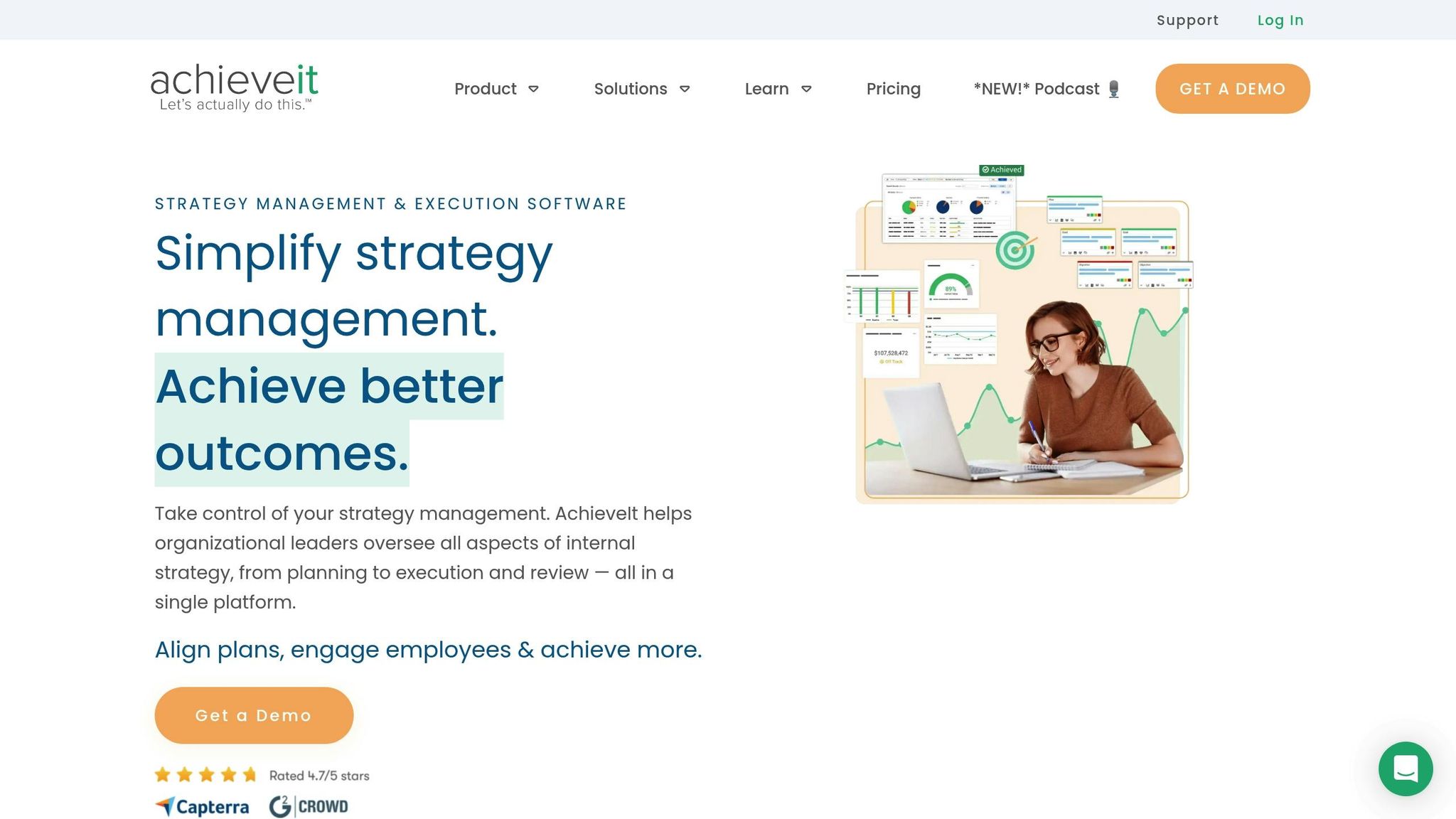
AchieveIt offers broad API connectivity, allowing it to integrate smoothly with key business systems like ERP, CRM, BI tools, and other essential applications. This integration makes it possible to pull data directly from financial systems, project management platforms, and operational databases without hassle.
In addition to its integration features, AchieveIt makes sharing strategic data straightforward with its powerful export options. These tools enable organisations to easily distribute critical information to external stakeholders while ensuring compatibility with their existing tech setups.
8. Cascade
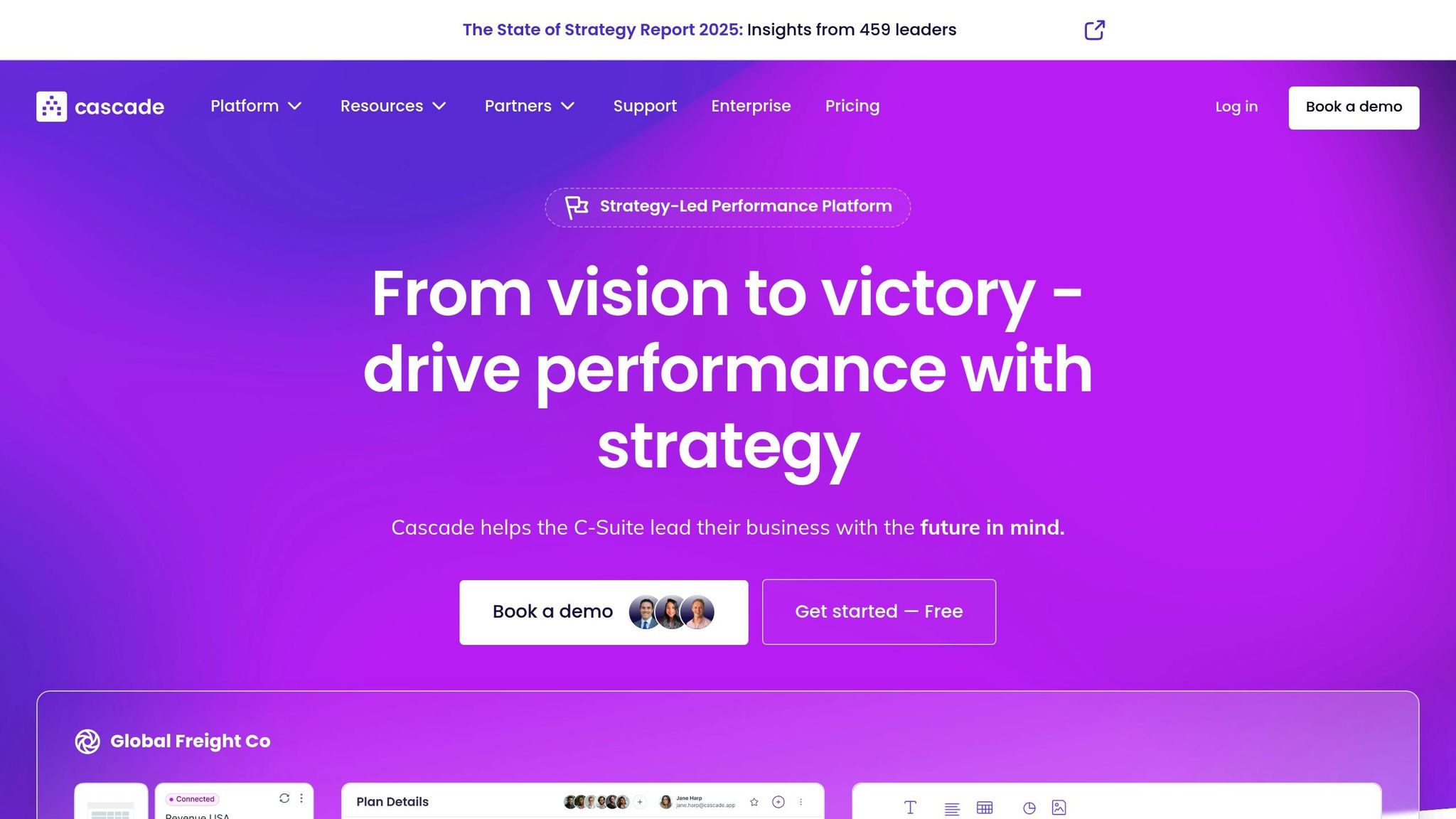
Cascade wraps up our comparison by offering a user-friendly way to plan strategies visually and effectively. Let’s dive into its standout features: real-time monitoring, integration options, and compliance tools.
Real-Time Monitoring
Cascade’s visual dashboards provide a clear, up-to-the-minute view of progress toward strategic goals. These dashboards automatically update metrics, helping users quickly spot any performance gaps. They can also be tailored to suit the needs of different groups, whether it’s top executives or department managers.
To make tracking even easier, the platform uses percentage completion indicators and color-coded statuses, so you can instantly see what’s on track and what needs attention. Plus, automated alerts can be set up to notify teams when metrics fall below specific thresholds, ensuring quick action when issues arise.
Integration Options
Cascade integrates seamlessly with popular tools like Microsoft Excel, Google Sheets, and Salesforce, pulling in data directly from your existing systems. This means no need to manually transfer data – everything flows smoothly.
For added flexibility, the platform supports CSV and Excel file uploads, making it simple to migrate data. For businesses with unique needs, Cascade also offers webhook support, allowing custom connections to proprietary systems.
Compliance Features
Governance is a breeze with Cascade’s built-in compliance tools. The platform keeps detailed audit trails, tracking every change made to strategic plans – perfect for industries with strict regulatory requirements.
It also includes role-based permissions, so you can control who can view, edit, or approve content. Need additional oversight? Approval workflows ensure that any changes require sign-off from the right stakeholders before going live.
To top it off, Cascade’s reporting tools generate polished, compliance-ready documents for board meetings, investor updates, or regulatory filings. Reports can even be scheduled for automatic creation and distribution, keeping everyone in the loop without extra effort.
Platform Strengths and Weaknesses
After diving into the detailed reviews of each platform, let’s distill their highlights and challenges. Every platform brings distinct advantages and trade-offs, making it crucial for organizations to align their choice with their specific needs and limitations. The table below provides a quick comparison of their primary strengths and weaknesses.
GrowthSquare shines with its AI-powered predictive controlling and the Art of Acceleration methodology, which offer real-time insights and foster shared understanding across teams. However, its advanced features demand extra training, especially for teams unfamiliar with AI-driven tools.
StratRocket excels at visual strategy mapping, simplifying complex plans into an easy-to-grasp format for all organizational levels. Its main drawback is the lack of robust AI-powered insights compared to other platforms.
i-nexus offers top-tier enterprise governance tools and detailed audit trails, making it ideal for large organizations. Yet, its comprehensive features can overwhelm smaller teams that don’t need such extensive governance systems.
Quantive is known for its seamless OKR integration and intuitive interface, which teams tend to adopt quickly. While it promotes collaboration effectively, it may fall short for organizations managing intricate, multi-layered strategies.
Perdoo stands out in team alignment and provides smooth workflows for setting and cascading goals. However, its reporting capabilities for executive-level analysis remain somewhat basic.
WorkBoard emphasizes real-time collaboration and offers excellent mobile accessibility, making it a favorite for teams focused on execution. On the downside, it lacks extensive customization options for unique organizational setups.
AchieveIt bridges strategic goals with operational tasks through project management integration and detailed tracking. That said, its interface can feel cluttered when juggling multiple complex initiatives.
Cascade impresses with its visual dashboards and effortless integration with existing tools, ensuring strategy progress is accessible and visible. Its limitation lies in the absence of advanced AI features, which are becoming increasingly sought after.
| Platform | Key Strengths | Primary Weaknesses |
|---|---|---|
| GrowthSquare | AI-powered predictive controlling, Art of Acceleration, real-time transparency | Requires more training for AI features |
| StratRocket | Visual strategy mapping, simplified communication | Limited AI-powered insights |
| i-nexus | Enterprise governance, audit trails | Can overwhelm smaller teams |
| Quantive | OKR integration, user-friendly interface | Lacks depth for complex strategies |
| Perdoo | Team alignment, intuitive goal-setting | Basic executive reporting |
| WorkBoard | Real-time collaboration, mobile-friendly | Limited customization options |
| AchieveIt | Project management integration, detailed tracking | Cluttered interface with multiple initiatives |
| Cascade | Visual dashboards, tool integration | Limited AI capabilities |
These comparisons underscore the importance of matching platform features to organizational priorities. For example, companies looking for cutting-edge AI insights often lean towards GrowthSquare, while those valuing visual simplicity might prefer StratRocket or Cascade. Large enterprises requiring robust governance tools gravitate toward i-nexus, while teams emphasizing collaboration and execution find Quantive or WorkBoard more appealing. Ultimately, the right platform can accelerate goal achievement and sharpen strategic focus, provided it aligns with the organization’s scale and goals.
Final Thoughts
Choosing a platform tailored to your organisation’s specific needs, size, and strategic goals is crucial. For German companies, especially, features like audit-proof archiving and AI-driven predictive controlling are indispensable in navigating today’s strict regulatory landscape. A solution with strong governance and comprehensive data management is key to transforming strategic plans into practical, operational success.
GrowthSquare rises to this challenge by offering more than just a traditional OKR framework. Its structured, forward-thinking approach delivers actionable insights while fostering alignment across teams. This not only simplifies strategy execution but also supports the operational excellence that German businesses demand.
By linking strategic planning with operational execution through data contextualisation, GrowthSquare ensures compliance with German regulations. Its robust governance features are designed to meet the high standards required in this market.
For organisations prioritising training and AI, GrowthSquare provides a dependable platform for long-term success. With its predictive intelligence, structured methodology, and advanced technology, it empowers forward-looking German companies to achieve their goals with precision – all while maintaining a strong focus on compliance and measurable outcomes.
FAQs
How does GrowthSquare use AI to optimise strategy execution more effectively than traditional approaches?
GrowthSquare uses AI-driven insights to transform how strategies are executed, providing real-time, data-backed recommendations that sharpen decision-making and streamline operations. Unlike older, static methods that rely on manual analysis, GrowthSquare’s AI actively tracks key performance indicators and applies predictive analytics to spot trends and risks early. This forward-looking approach can cut errors by up to 33% and trim development timelines by as much as 30%.
This capability supports more flexible and precise strategy execution, perfectly aligning with Germany’s focus on innovation and operational efficiency. Companies gain the advantage of quicker, smarter decisions, keeping them competitive in today’s rapidly changing market landscape.
How does GrowthSquare ensure compliance with German regulations like GDPR and the IT Security Act 2.0?
GrowthSquare is built to support businesses in adhering to German regulatory standards like GDPR and the IT Security Act 2.0. It provides strong data protection tools, including consent management systems, secure data storage solutions, and privacy-focused policies that align with GDPR guidelines.
To meet the requirements of the IT Security Act 2.0, GrowthSquare integrates advanced security features. These include comprehensive documentation of security protocols and optional certifications to bolster your organisation’s security framework. With these measures, GrowthSquare helps protect sensitive data while fostering trust and ensuring compliance with Germany’s strict regulatory landscape.
How does GrowthSquare integrate with existing business systems to improve strategy execution?
GrowthSquare’s integration capabilities are designed to work smoothly with your current business systems, streamlining the way strategies are executed. With its AI-powered platform, it delivers real-time updates on operational activities, helping you spot potential problems early and respond quickly with precision.
The Art of Acceleration (AOA) approach ensures a well-organized and efficient flow of data between strategy and operations. This unified database boosts transparency, aligning your strategic goals with everyday tasks. The result? A seamless path to achieving your business objectives without unnecessary interruptions.
